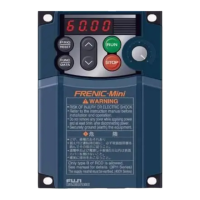6.2 Selecting Wires and Crimp Terminals
6-3
Chap. 6 SELECTING PERIPHERAL EQUIPMENT
Currents Flowing across the Inverter Terminals
Table 6.1 summarizes average (effective) electric currents flowing across the terminals of each
inverter model for ease of reference when selecting peripheral equipment, options and electric wires
for each inverter--including supplied power voltage and applicable motor rating.
Table 6.1 Currents Flowing through Inverter
50Hz, 200V / 400V (380V) 60Hz, 220V (200V) / 440V (380V)
Input RMS current (A)
DC link
Input RMS current (A)
DC link
bus current bus current
w/ DCR w/o DCR (A) w/ DCR w/o DCR (A)
0.1 1/8 0.57 1.1 0.70 - 0.51 (0.55) 1.1 (1.1) 0.62 (0.67) -
0.2 1/4 0.93 1.8 1.1 - 0.85 (0.92) 1.7 (1.8) 1.0 (1.1) -
0.4 1/2 1.6 3.1 2.0 1.2 1.5 (1.6) 3.0 (3.0) 1.8 (2.0) 1.2
0.75 1 3.0 5.3 3.7 1.6 2.8 (3.0) 5.0 (5.3) 3.4 (3.7) 1.6
Three- 1.5 2 5.7 9.5 7.0 3.6 5.2 (5.6) 9.0 (9.5) 6.3 (6.9) 3.6
Phase 2.2 3 8.3 13.2 10.2 3.5 7.6 (8.3) 12.3 (13.2) 9.3 (10.1) 3.5
200V 3.7 5 14.0 22.2 17.2 4.1 12.7 (13.9) 20.6 (22.2) 15.6 (17.0) 4.1
5.5 7.5 21.1 31.5 25.9 6.4 19.0 (20.9) 28.4 (31.2) 23.3 (25.6) 6.4
7.5 10 28.8 42.7 35.3 6.1 26.0 (28.6) 38.5 (42.3) 31.9 (35.1) 6.1
11 15 42.2 60.7 51.7 9.1 38.0 (41.8) 54.7 (60.1) 46.6 (51.2) 9.1
15 20 57.6 80.0 70.6 11.0 52.0 (57.1) 72.2 (79.4) 63.7 (70.0) 11.0
0.4 1/2 0.81 (0.85) 1.6 (1.7) 0.99 (1.0) 0.8 0.74 (0.85) 1.7 (1.7) 0.91 (1.0) 0.8
0.75 1 1.5 (1.6) 2.9 (3.0) 1.8 (1.9) 1.1 1.4 (1.6) 3.0 (3.0) 1.7 (2.0) 1.1
1.5 2 2.9 (3.0) 5.7 (5.7) 3.5 (3.6) 1.8 2.6 (3.0) 5.1 (5.9) 3.2 (3.6) 1.8
Three- 2.2 3 4.2 (4.4) 7.9 (7.9) 5.1 (5.3) 1.8 3.8 (4.3) 7.1 (8.2) 4.6 (5.3) 1.8
Phase 3.7 5 7.0 (7.3) 12.5 (13.0) 8.6 (9.0) 2.1 6.4 (7.3) 11.1 (12.9) 7.8 (8.9) 2.1
400V 5.5 7.5 10.6 (11.2) 17.3 (18.2) 13.0 (13.7) 3.2 9.6 (11.1) 15.7 (18.2) 11.8 (13.7) 3.2
7.5 10 14.4 (15.2) 23.2 (24.2) 17.7 (18.6) 3.1 13.0 (15.1) 21.0 (24.3) 16.0 (18.5) 3.1
11 15 21.1 (22.2) 33.0 (34.7) 25.9 (27.3) 4.5 19.0 (22.0) 29.8 (34.5) 23.3 (27.0) 4.5
15 20 28.8 (30.3) 43.8 (46.1) 35.3 (37.2) 5.7 26.0 (30.1) 39.5 (45.7) 31.9 (36.9) 5.7
0.1 1/8 1.1 1.8 1.1 - 1.0 (1.1) 1.8 (1.8) 1.0 (1.1) -
Single- 0.2 1/4 2.0 3.2 2.0 - 1.8 (1.9) 3.1 (3.2) 1.8 (1.9) -
Phase 0.4 1/2 3.5 5.2 3.5 0.82 3.1 (3.4) 5.0 (5.4) 3.1 (3.4) 0.82
200V 0.75 1 6.4 9.5 6.4 1.4 5.8 (6.3) 9.1 (9.7) 5.8 (6.3) 1.4
1.5 2 11.7 16.0 11.7 1.4 10.5 (11.3) 15.5 (16.4) 10.5 (11.3) 1.4
2.2 3 17.5 24.2 17.5 1.7 15.8 (17.0) 23.4 (24.8) 15.8 (17.0) 1.7
0.1 1/8 2.1 3.5 - - 2.1 (2.3) 3.6 (4.0) 2.1 (2.3) -
0.2 1/4 3.8 5.8 - - 3.7 (4.1) 5.9 (6.5) 3.7 (4.1) -
0.4 1/2 6.4 9.4 - 0.82 6.3 (6.9) 9.5 (10.5) 6.3 (6.9) -
0.75 1 12.0 16.0 - 1.4 11.6 (12.8) 16.1 (17.7) 11.6 (12.8) -
Power
supply
voltage
Applicable
motor
(kW)
Applicable
motor
(HP)
Single-
Phase
100V
DC reactor (DCR)
Braking
resitor circuit
current (A)
Braking
resitor circuit
current (A)
DC reactor (DCR)
- Inverter efficiency is calculated using values suitable for each inverter model. The input route mean
square (RMS) current is calculated according to the following conditions:
Power source capacity: 500 kVA; power source internal impedance: 5%
- The current listed in the above table will vary in inverse proportion to the power supply voltage,
such as 230 VAC and 460 VAC.
- The braking current is always constant, independent of braking resistor type (standard and
10%ED).

